ip access IPA219C 3G Picocellular basestation User Manual nano3GAP Operations Manual
ip.access ltd 3G Picocellular basestation nano3GAP Operations Manual
Contents
- 1. Installation guide
- 2. Operating guide
- 3. Installation manual
- 4. Operating manual
Operating guide

nano3GAP Operations Manual
N3G_OPM_300 1.0 ip.access Ltd
Building 2020
Cambourne Business Park
Cambourne
Cambridgeshire CB23 6DW
United Kingdom
www.ipaccess.com

nano3GAP Operations Manual
© ip.access Ltd
Revision History
Version Change Summary Date Author
0.1 First draft 21 Jul 2009 ZN1
0.2 Updates throughout the manual 24 Jul 2009 ZN1
0.3 Updated from feedback 27 Jul 2009 ZN1
0.4 Style sheet corrections 28 Jul 2009 AM4
0.5 Implemented review corrections 29 Jul 2009 ZN1
0.6 Implemented further review comments 29 Jul 2009 ZN1
1.0 Released for N3G_1.1 29 Jul 2009 ZN1
Approved by e-mail.
The information contained in this manual is commercially confidential and must not be
disclosed to third parties without prior consent.

nano3GAP Operations Manual
© ip.access Ltd
Table of Contents
1 Introduction ..................................................................................................... 1
1.1 Overview ........................................................................................................... 1
1.1.1 Configuration from a Provisioning PC.................................................................... 1
1.1.2 Configuration and Administration from the OMC-R Client ..................................... 1
1.2 Related Information........................................................................................... 1
1.3 Terminology ...................................................................................................... 2
2 Common Procedures...................................................................................... 3
2.1 Restart a nano3GAP......................................................................................... 3
2.2 Using the OMC-R Client ................................................................................... 3
2.2.1 Start the OMC-R Client .......................................................................................... 3
2.2.2 Find an AP in the OMC-R ...................................................................................... 5
2.2.3 Change the Administrative State of an AP............................................................. 5
2.3 nano3GAP-4 Objects in the OMC-R ................................................................. 6
2.3.1 Useful Information .................................................................................................. 6
2.3.2 Actions.................................................................................................................... 7
2.3.3 AP Configuration .................................................................................................... 9
2.4 Using Network Listen ........................................................................................ 9
2.4.1 Run Network Listen Tests ...................................................................................... 9
2.4.2 View Network Listen results ................................................................................. 10
2.4.3 Apply Frequency Correction................................................................................. 11
3 Troubleshooting the nano3GAP.................................................................. 13
3.1 Monitoring Alarms from the nano3GAP .......................................................... 13
3.2 Modifying the AP Configuration ...................................................................... 13
3.2.1 Create an Attribute Configuration File for an AP.................................................. 13
3.2.2 Download the Attribute Configuration File to the AP............................................ 13
3.3 Modifying the AP-AC Connection ................................................................... 13
3.3.1 Modify the Connection to the AP.......................................................................... 13
3.3.2 Edit the IP Configuration of the AP ...................................................................... 13
3.4 AP Diagnostics from the OMC-R .................................................................... 14
3.4.1 Automatic Crash Log Upload ............................................................................... 14
3.4.2 Report Diagnostics............................................................................................... 14
3.4.3 Diagnostics Tuning of the AP............................................................................... 16
3.5 Factory Reset.................................................................................................. 17

nano3GAP Operations Manual Introduction
© ip.access Ltd Page 1
1 Introduction
This document provides information on managing and troubleshooting the ip.access
nano3GAP-4 AP, an indoor local area access point.
1.1 Overview
This manual is intended for use by individuals engaged in the day-to-day management of
the nano3GAPs. It describes direct operation, administration and maintenance of the APs.
1.1.1 Configuration from a Provisioning PC
The nano3GAP includes a web server that can be accessed via a web browser running on
the provisioning PC. The web server can be used during commissioning only because it is
only available when the AP is in the factory reset state.
For instructions, see [INST_300].
1.1.2 Configuration and Administration from the OMC-R Client
A nano3GAP can be configured and managed from the OMC-R Client, a Java application
that can run on Windows. It connects to the OMC-R Server, which in turn connects to one
or more ACs. Hence, the OMC-R Client can provide a view of the whole network. This
view may be restricted according to user permissions.
Following commissioning (see [INST_300]), nano3GAP objects are created automatically
by the AC to which the AP first connected. Once a 3GAP object has connected to a
nano3G AC, they are visible in the OMC-R, and they can be configured and managed
remotely. When a nano3GAP has been added to the database, its configuration attributes
can be changed in the OMC-R Client and additional features, such as Measurement
Functions, can be used with the nano3GAP. Furthermore, the OMC-R Client has full alarm
management capability. Alarm notifications from a nano3GAP or the controlling AC are
grouped into lifecycles according to the unique ID of the object that raised an alarm.
Hence, the alarm status of a particular object can be tracked as it changes, until the
lifecycles ends when the alarm clears. Alarms can be acknowledged and optionally notes
may be added to an alarm.
For more information, see [OPM_410].
1.2 Related Information
[GST_100] nano3G System Overview Manual (N3G_GST_100)
[GST_300] nano3GAP Product Description (N3G_GST_300)
[INST_300] nano3GAP Installation Manual (N3G_INST_300)
[OPM_410] nano3G OMC-R Client Operations Manual (N3G_OPM_410)
[OPM_430] nano3G PM/DL Server Operations Manual (N3G_OPM_430)
[REF_105] nano3G System Glossary (N3G_REF_105)

nano3GAP Operations Manual Introduction
© ip.access Ltd Page 2
[REF_130] nano3G Alarm Data Reference Manual (N3G_REF_130)
[21.905] Vocabulary for 3GPP Specifications, 3rd Generation Partnership Project
1.3 Terminology
For standard nano3G System terminology, see [REF_105].
For additional standard GSM terminology, see [21.905].
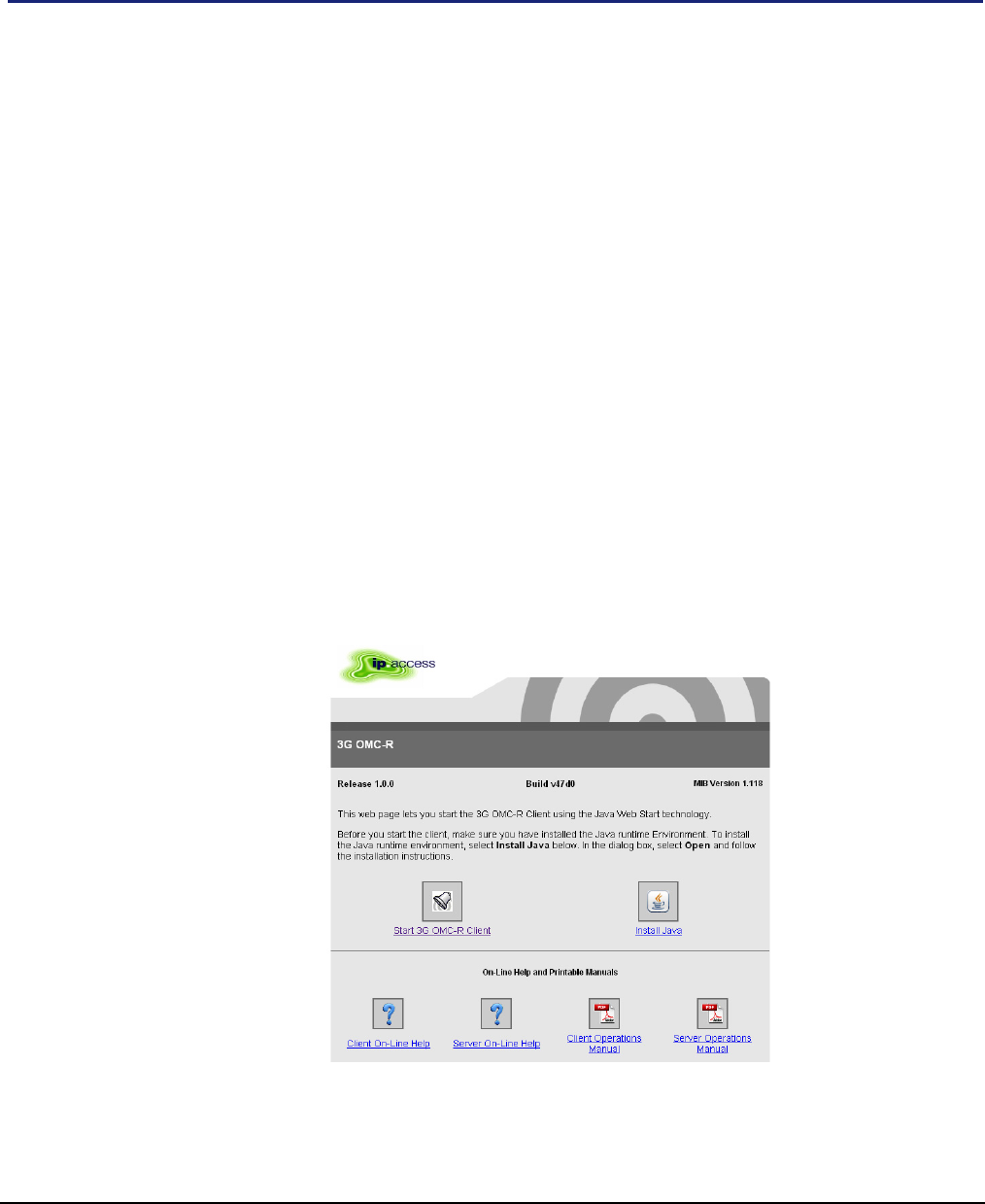
nano3GAP Operations Manual Common Procedures
© ip.access Ltd Page 3
2 Common Procedures
2.1 Restart a nano3GAP
To restart an AP:
• Power cycle it.
• Invoke a reinitialize action from the OMC-R, see section 2.3.2.
The AP will start up in the same administrative state in which it was before the restart.
2.2 Using the OMC-R Client
2.2.1 Start the OMC-R Client
The OMC-R Server provides a web page to start the OMC-R Client.
1) Start a web browser application.
2) Enter the URL for the OMC-R server’s web page as:
http://<server-hostname>/omcr
Where <server-hostname> is the fully qualified hostname of the OMC-R server.
Note: This assumes that DNS is correctly configured on the management
network: the OMC-R server can be found by using its host name from
client computers on the same network.
3) Press the Enter key and the OMC-R web page will be displayed.
4) If it has not been installed on the client computer, click the link to download and
install the Java runtime (JRE version 1.5) for Windows®. This will allow a
Windows® client computer to run the OMC-R Client.
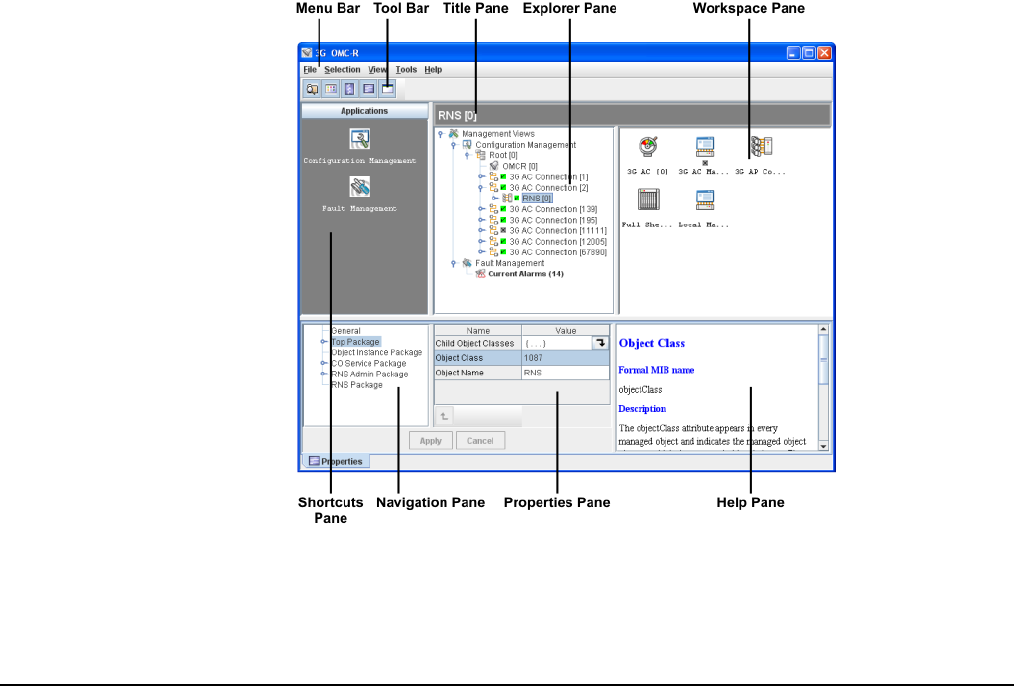
nano3GAP Operations Manual Common Procedures
© ip.access Ltd Page 4
Note: When installed on Windows®, the JRE may automatically update to
version 1.6. The OMC-R Client will operate correctly with JRE 1.6.
However, do not install any version later than 1.6 (or allow JRE to be
automatically updated; for example, decline the update if prompted). The
Java Control Panel may be used to disable automatic updates and/or
disable usage of JRE versions later than 1.6.
5) The OMC-R Client is automatically installed when it is started. Click the link or
icon for Start 3G OMC-R Client.
If this is the first time the OMC-R Client has been started from this client
computer, or if the client version on the OMC-R Server has been updated, the
client application will download (which also installs the application).
If a security warning appears about verification of the digital signature for the
application, click the Run button.
6) The OMC-R Client will initialize and connect to the OMC-R Server. A login prompt
will appear. The first time the client is used from a particular computer, the User
name will be set to the login ID used for the current session on the client
computer.
7) Enter the username and password, then click OK. The user name will be
remembered at the next login.
8) The OMC-R Client will initialize and connect to the OMC-R Server.
The following screen appears:
9) Double-click through the tree (Management Views > Configuration Management)
to navigate to the AP to configure.

nano3GAP Operations Manual Common Procedures
© ip.access Ltd Page 5
2.2.2 Find an AP in the OMC-R
Note: The serial number of the required AP must be known.
1) Click the handles to open the Management Views and Configuration Management
nodes in the Explorer pane, then the Network View and Root nodes. The ACs
connected to the OMC-R will be listed.
2) Open the node for the AC serving the required AP, then open its RNS node and
then the ApController node. The ApConnections will be shown for all the APs
connected to the AC.
2.2.3 Change the Administrative State of an AP
The nano3GAP has the following administrative states:
• Locked
• Shutdown
• Unlocked
Most attributes can be configured with the AP in the unlock state, but some attributes can
only be configured when an AP is in the locked state and does not provide operational
service. The attributes that require the AP to be in the locked state are shown in red in the
Properties pane.
To change the Administrative State:
1) Find the required AP in the OMC-R (as above).
2) Right-click the AP object (below the ApConnection object). A context menu will
appear. The menu includes three administrative state options (the current state is
unavailable, or 'greyed out'):
o Lock
Lock the AP immediately. This will take the AP out of service immediately.
Any active calls will be dropped and UEs camped on are disconnected. A
padlock is shown against the AP object and its administrative state is set to
Locked.
o Shutdown
Lock the AP as soon as all active calls have ceased. This will take the AP
out of service and lock it as soon as all active calls are complete. No new
calls can be established. UEs camped on are disconnected. An arrow
pointing down is shown against the AP object, which changes to a padlock
once it locks.
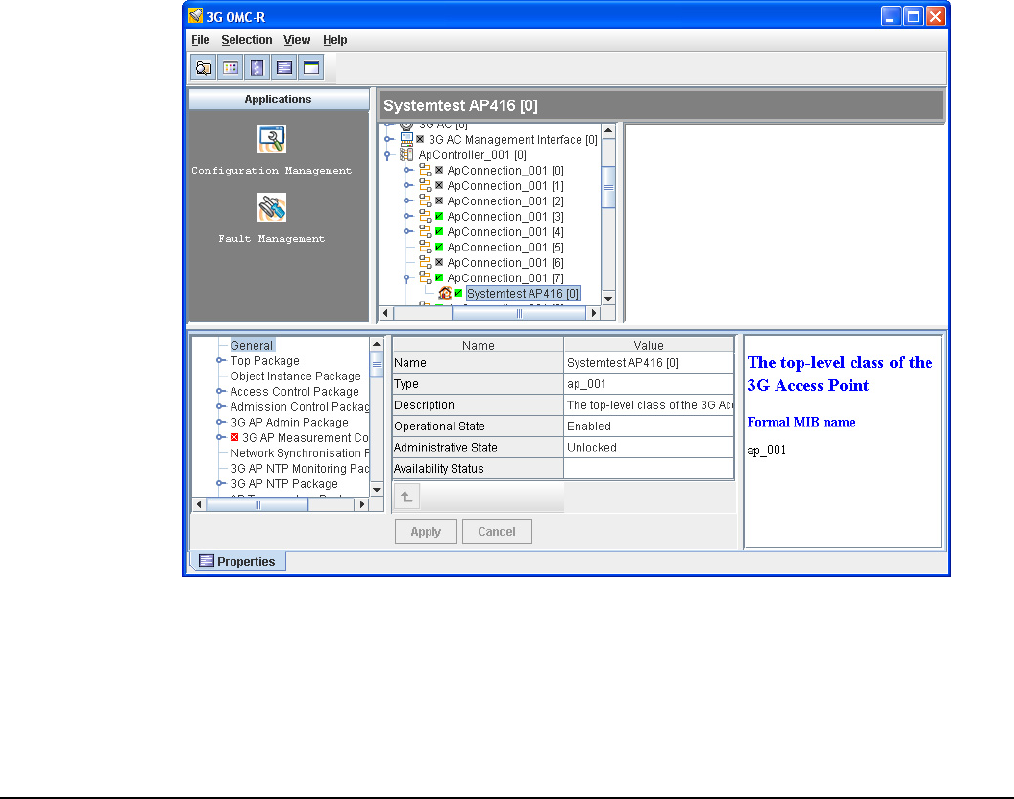
nano3GAP Operations Manual Common Procedures
© ip.access Ltd Page 6
o Unlock
Return the AP into service so that it may allow UEs to camp on and make
calls.
3) Click the menu option for the required Administrative State.
2.3 nano3GAP-4 Objects in the OMC-R
The AP object in the OMC-R can be used to:
• Provide information about the AP.
• Configure the AP.
• Perform other actions on an AP (such as changing administrative state).
2.3.1 Useful Information
2.3.1.1 General Information
When an AP object is selected in the Explorer or Workspace pane, the General package is
initially selected in the Navigation pane, with its attributes shown in the Properties pane.
This shows the basic state of an AP in terms of Operational State, Administrative State
and Availability Status. An AP should be providing service normally when these are
indicated as Enabled, Unlocked and blank respectively (as in the example above). The
Availability Status usually only has a value when the AP is not providing service. This
information is also shown by a tooltip when the mouse pointer is paused over an AP
object.

nano3GAP Operations Manual Common Procedures
© ip.access Ltd Page 7
Select the AP Admin Package to see more information about the general status of an AP.
In particular, this shows the MIB Version, which must match the MIB Version used by the
OMC-R and the AC.
2.3.1.2 Bands Supported
To verify the UMTS bands supported by the AP hardware, go to the Network Listen Status
Package and drill down to UMTS Bands Supported.
The GSM bands supported by NWL can also be inspected, to show the valid bands to use
when configuring the Static GSM Neighbour List.
2.3.1.3 Hardware Information
To check the exact hardware version of an AP, select the Factory NV Package in the
Navigation pane and inspect the Hardware Version attribute. This package also shows the
serial number and other factory configured information.
2.3.2 Actions
The context menu for the AP object (available from right-click on the object) has an Actions
sub-menu:
Action Behaviour
Enable Service Automatically initiated by the nano3G AC once the BSMIS
Synchronisation procedure has completed and the AC is ready for the
AP to start providing service.
Lock Changes the administrative state to LOCKED.
The AP immediately releases all RRC connections and turns off its
radio.
Reinitialise The AP will reboot.
Shutdown Changes the administrative state to SHUTTING_DOWN.
The AP will wait until all RRC connections are closed before turning off
the radio and transitioning to the locked state.
Unlock Changes the administrative state to UNLOCKED.
The AP will turn on its radio.
Report Alarms Generates an alarm report.
If no parameters are provided, the configuration from the Alarm Report
Control package is used. The value of the attribute alarmReportDetail
specifies the content of the report and the value of the attribute
alarmReportingUrl specifies its destination.
The component behaviour on receiving this action is similar to the
component behaviour for Periodic Alarm Reporting. The key difference
is that the periodic timers are left unchanged while the time of the next
scheduled report remains the same.

nano3GAP Operations Manual Common Procedures
© ip.access Ltd Page 8
Report
Diagnostics Now
The AP will report its current log files to the URL contained in the action.
Perform
Software
Download
The AP will download the new software image from a specified URL.
The optional attribute swDownloadOps controls what operations the AP
performs following the download; this can be used to change the default
SW version of the AP and to reboot it. If this parameter is not present,
then the AP performs the download and changes the default SW
version, but does not reboot.
Swap Default
Software
The AP will change its default software version, that is, the software that
will be run the next time the AP reboots.
The attribute defaultSwVersion in the AP Admin package, which reports
the current default software version, will change when the Swap Default
Software action is completed.
Report
Measurements
The AP wil send a measurement report, as set up in the Measurement
Control package. The component behaviour on receiving this action is
similar to the component behaviour for Periodic Measurement
Reporting. The key difference is that the periodic timers are left
unchanged while the time of the next scheduled report remains the
same.
Abort Network
Listen Test
Stops all Network Listen activities and resets the value of the attribute
nwlTestStatus to "NWL_IDLE".
Apply Frequency
Correction
Uses the results of the most recent BCCH Detect test to adjust the
crystal oscillator of the AP. When the adjustment is done, the value of
the attribute estimatedFreqOffset is set to zero.
Frequency correction is not possible if either the value of the attribute
estimatedFreqOffset is zero or the BCCH Detect results are older than
one hour.
Factory Restore Restores the AP settings to their factory defaults and triggers a
reinitialization.
Start BCCH
Detect Test
Invokes the BCCH Detect Test that performs an RSSI scan followed by
an attempt to decode BCCH (GSM) and CPICH (UMTS) for each
ARFCN or UARFCN that has an RSSI value above the associated
decode threshold.
Note: This test is recommended only as part of a diagnostic
procedure.
Start RSSI Scan
Test
Invokes the RSSI Scan Test that scans the enabled bands and
ARFCNs.
Note: This test is recommended only as part of a diagnostic
procedure.
Start Sequential
NWL Tests
Invokes a sequence of Network Listen tests: RSSI scan, BCCH Detect
Test and Frequency Accuracy Test. The order of the tests is identical to
that of a scheduled NWL test.
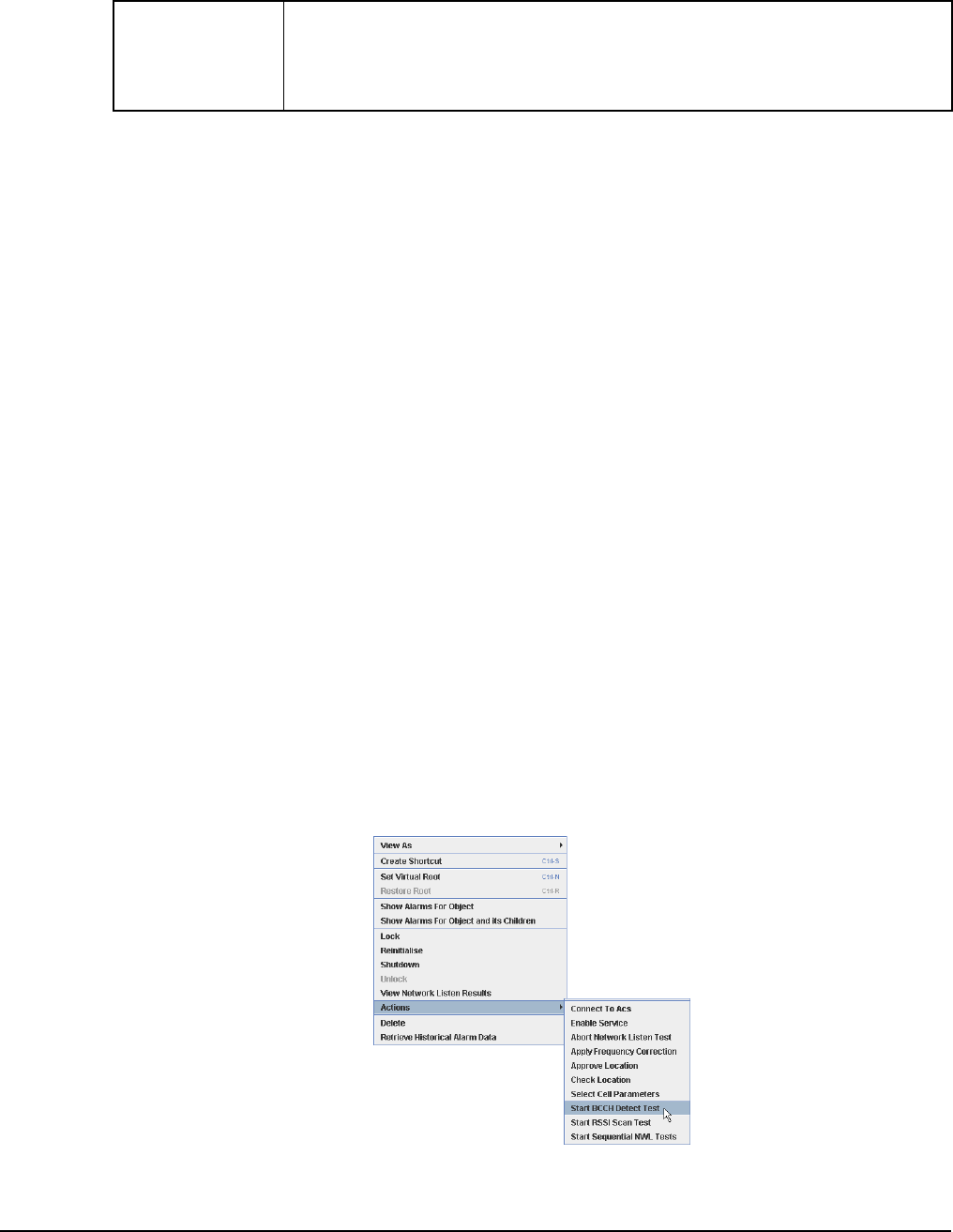
nano3GAP Operations Manual Common Procedures
© ip.access Ltd Page 9
Delete CRLs The AP will delete its CRLs. The currently open secure connections are
not disconnected. The next time the AP attempts to open a secure
connection, it has to connect to the CRL server to get an up-to-date
CRL.
2.3.3 AP Configuration
The essential configuration steps for commissioning an AP using the OMC-R are
described in [INST_300]. This section provides additional information about configuration
changes that may be of interest.
• Network Listen Control Package
• Cell Package
• NAS Package
• Location Package
2.4 Using Network Listen
Network Listen (NWL) is used by a nano3GAP to scan the local RF environment and
gather information from neighbouring cells. Network Listen can detect WCDMA cells, both
macro and other nano3G and GSM cells. The AP can use the information gathered for the
following:
• Check neighbour cells for handover and reselection
• Automatic clock frequency calibration
2.4.1 Run Network Listen Tests
1) Find the required AP by its serial number or object name (see section 2.2.2).
2) Right-click the AP object and a menu will appear.
3) Move the pointer down to Actions and a sub-menu will appear.
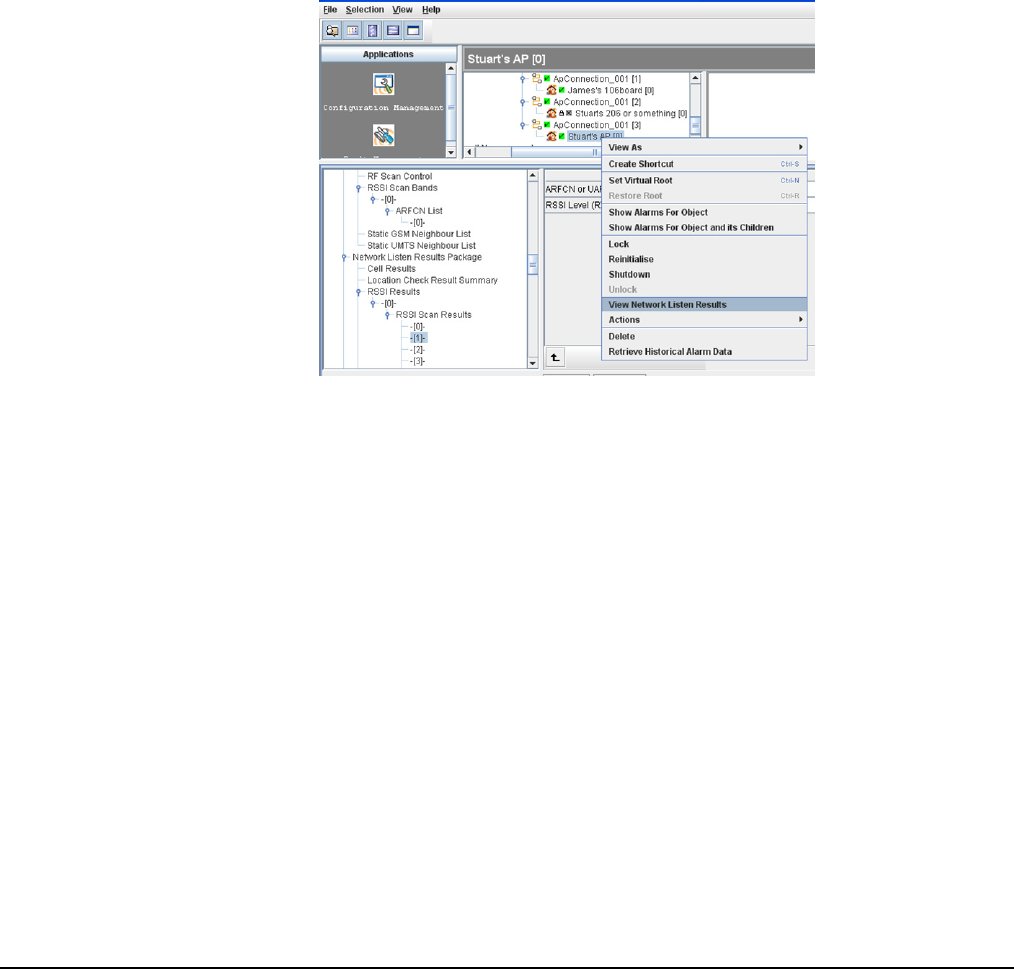
nano3GAP Operations Manual Common Procedures
© ip.access Ltd Page 10
4) Click Start BCCH Detect Test, Start RSSI Scan Test or Start Sequential NWL
Tests.
5) The AP will administratively shut down (wait for calls to complete) and lock, then
the tests will run. The AP will then unlock once the tests are complete.
2.4.2 View Network Listen results
Once the nano3GAP has booted up and performed an RF scan, it is possible to see the
results in the OMC-R Client.
1) Find the required AP by its serial number or object name (see section 2.2.2).
2) Right-click the AP object and select View Network Listen Results from the
menu.
3) The Network Listen Results viewer will appear (see below).
4) Alternatively, select the Network Listen Results Package in the Navigation pane
and select the following:
o Cell Results
o RSSI Results
o UMTS UL Results
The view has a graphical representation of the Network Listen results on the Chart tab,
and a list of detected cells on the Table tab.
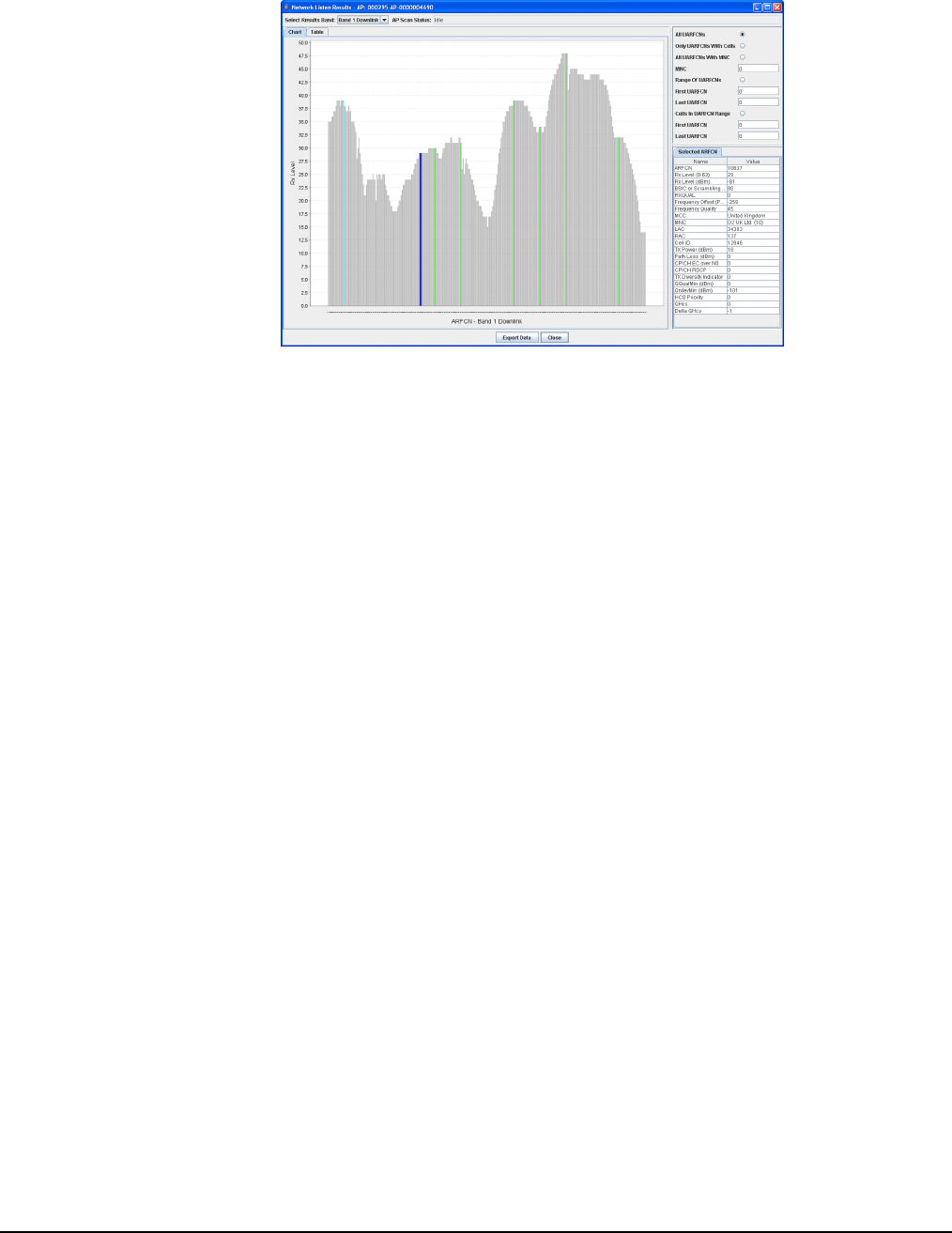
nano3GAP Operations Manual Common Procedures
© ip.access Ltd Page 11
Click a detected cell (in Chart view the line changes to blue) to show more details in the
Selected ARFCN tab on the right.
Note: Optionally use the detected results to fill in the static neighbour lists.
2.4.3 Apply Frequency Correction
First check the possible frequency adjustment as follows:
1) Find the required AP by its serial number or object name (see section 2.2.2).
2) In the Navigation pane, select the Network Listen Status Package.
3) In the Properties pane, inspect the Estimated Frequency Offset (PPB) value.
4) If the offset magnitude is more than 50 (that is more than +50 or less than -50), it
may be useful to apply frequency correction.
Note: If the offset is within +/- 50ppb, that offset will never be used. A correction
will only be applied if the Network Listen results are more than 10
minutes old and a rescan results in a recalculated offset magnitude
greater than 50ppb.
If it is necessary to apply a frequency correction, use the following procedure:
5) Right-click the AP object and a menu will appear.
6) Select Shutdown and wait for the AP to lock or Lock to lock the AP immediately.
7) When the AP is locked, with the padlock symbol, right-click the AP object again
and the menu will appear.
8) Move the pointer down to Actions and a sub-menu will appear.
9) Click Apply Frequency Correction. The AP will do the following:
o The time of the last scan is checked. If the scan is older than 10 minutes, a
new scan takes place and a replacement offset value is recalculated. If the
offset is smaller than +/- 50ppb, there is no further action (that is, no offset is
applied).

nano3GAP Operations Manual Common Procedures
© ip.access Ltd Page 12
Note: When no offset is applied, the NWL Test Status in the Network Listen
Status Package is set back to NWL Idle. This can happen very quickly
and there may be no visible change to NWL Test Status. If the NWL Test
Status appears to have stayed at NWL Idle for more than one minute, it
can be assumed that nothing has happened and the AP may be
unlocked.
o If the process continues, the frequency correction is applied.
o A new scan takes place to check that the new setting has improved the
frequency offset. If the new offset is worse than the offset just applied, the
frequency correction is reversed. Otherwise, the new value is retained.
o The Estimated Frequency Offset (PPB) value in the Network Listen Status
Package is reset to 0 until the offset is recalculated by another Network
Listen scan. The NWL Test Status in the Network Listen Status Package is
set to NWL Idle.
10) Right-click the AP object again and select Unlock.

nano3GAP Operations Manual Troubleshooting the nano3GAP
© ip.access Ltd Page 13
3 Troubleshooting the nano3GAP
3.1 Monitoring Alarms from the nano3GAP
For instructions see [OPM_410]. For information on the alarms, see [REF_130].
3.2 Modifying the AP Configuration
3.2.1 Create an Attribute Configuration File for an AP
The properties of the AP can be set from the OMC-R. Optionally, attributes can be
imported from a text file.
For the description of the text file format and for instructions on how to use it, see
[INST_300].
3.2.2 Download the Attribute Configuration File to the AP
For instructions, see [INST_300].
3.3 Modifying the AP-AC Connection
The configuration of a nano3GAP can be modified in a web interface from the provisioning
PC. The AP-AC connection and the IP configuration of the AP can be managed this way.
The web interface is only enabled by default during commissioning when the AP is in
factory reset state. To enable the web interface, the nano3GAP needs to be put into
factory reset state (see section 3.5).
1) Start a web browser and go to the following address:
http://192.168.0.1:8089/
2) Enter the username and password.
3.3.1 Modify the Connection to the AP
For instructions, see [INST_300].
3.3.2 Edit the IP Configuration of the AP
For instructions, see [INST_300].

nano3GAP Operations Manual Troubleshooting the nano3GAP
© ip.access Ltd Page 14
3.4 AP Diagnostics from the OMC-R
3.4.1 Automatic Crash Log Upload
It is possible to enable uploading a crash log file automatically from the OMC-R to a server
that is capable of HTTPS PUT.
Note: By default Apache does not allow HTTP PUT.
The apfiaglog file is created by a bash script /opt/ipaccess/bin/diagupload. It collates all of
the files needed to troubleshoot and analyse issues in the field. The diagupload script will
create a tar.gz file stored temporarily in the /tmp folder, for example:
apdiaglogs_000295-000000007804_1246441198_demand.tar.gz
The tar file contains the following files:
File Description
tcpdump.pcap0 and 1 Rolling tcpcapture.
procmon output Contains the same information as the printout of the ps
command, with additional details. Furthermore, it contains
a log rotated version that is updated every 30 seconds,
which helps when looking for memory leaks.
Log files For example: dmesg, bootlogs, apdiag cli output, syslog,
klog
Legacy configuration files
Software version information
Crash files In case of a crash
3.4.2 Report Diagnostics
To generate a status report of the AP:
1) Log in to the OMC-R.
2) Find the required AP by its serial number or object name (see section 2.2.2).
3) Right-click the AP object and select Report Diagnostics Now from the menu.
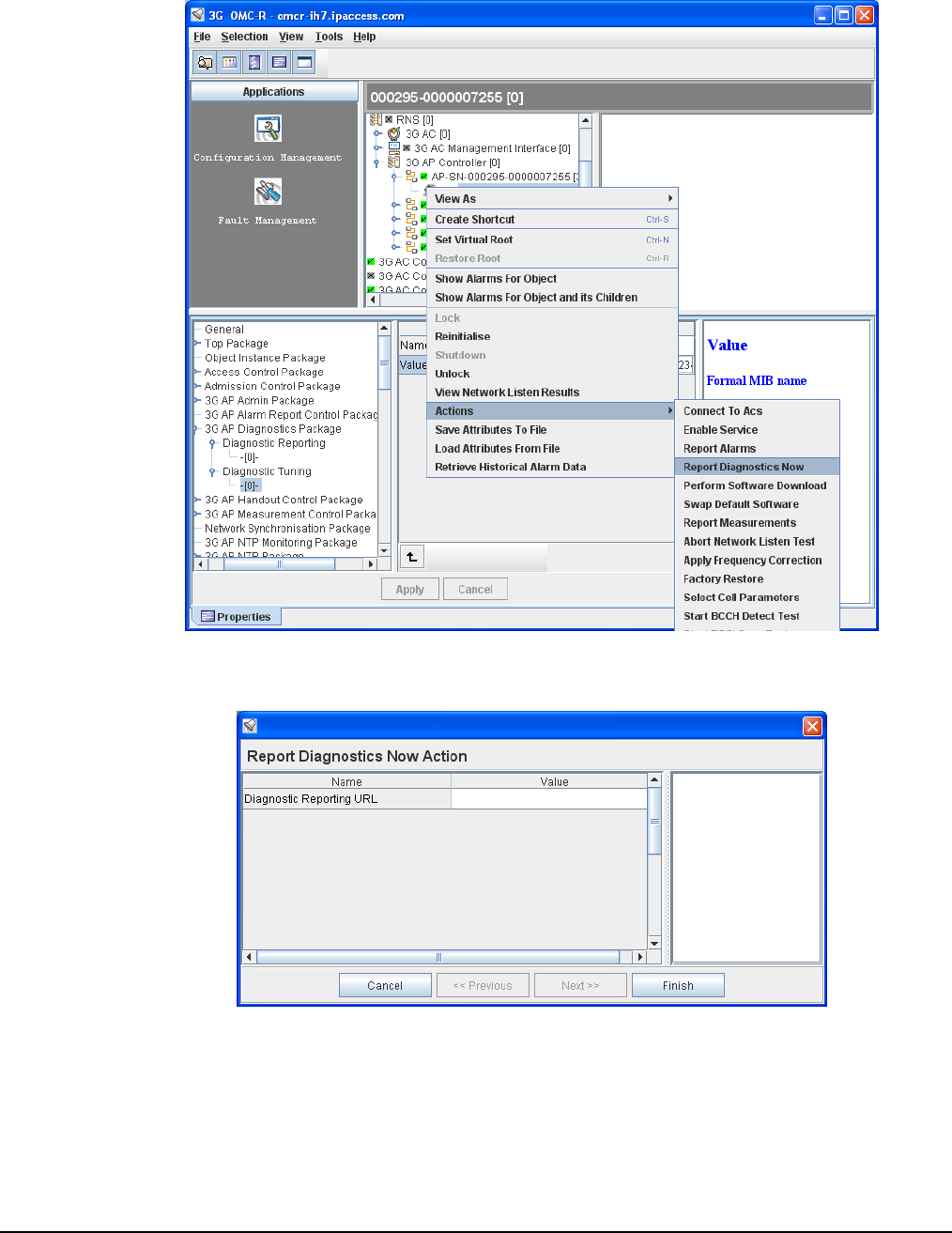
nano3GAP Operations Manual Troubleshooting the nano3GAP
© ip.access Ltd Page 15
4) Enter the URL where the diagnostic report should be displayed.
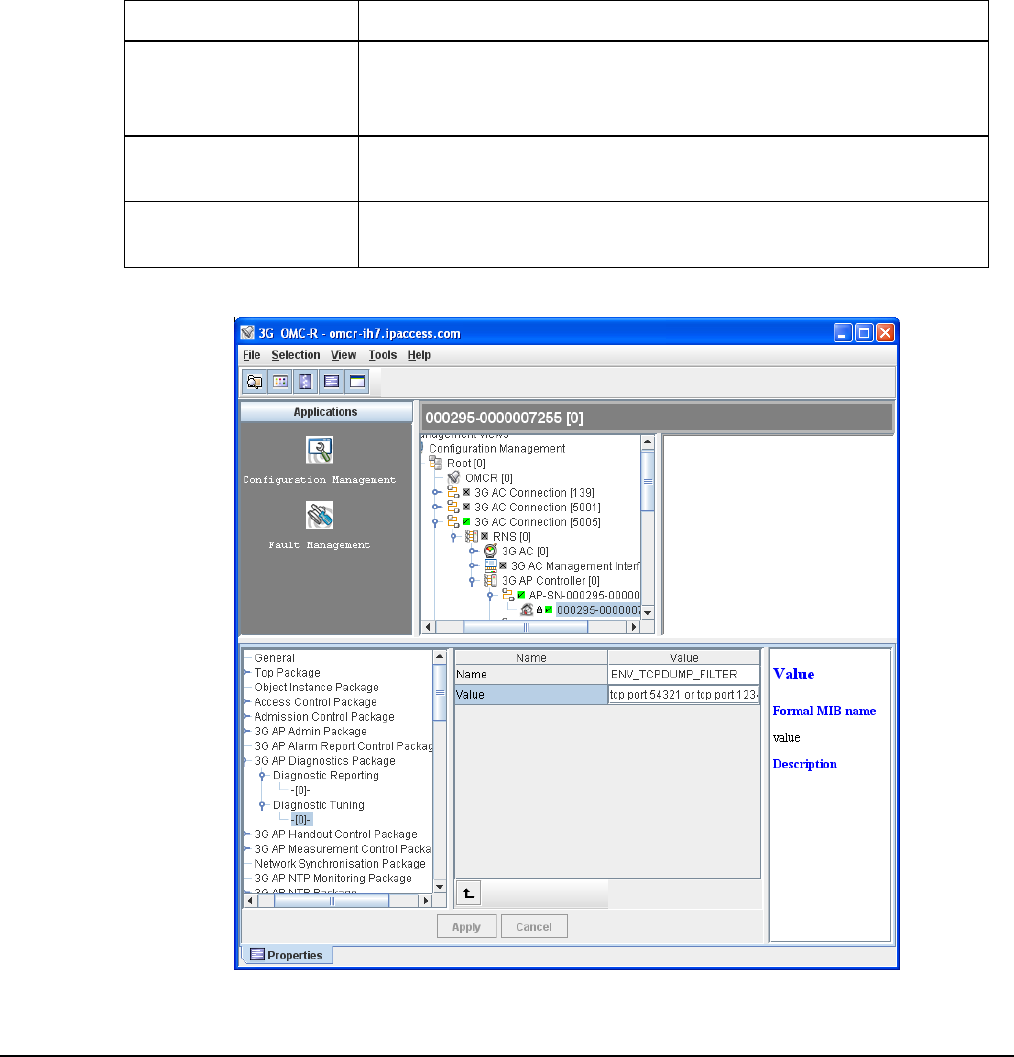
nano3GAP Operations Manual Troubleshooting the nano3GAP
© ip.access Ltd Page 16
3.4.3 Diagnostics Tuning of the AP
It is possible to modify some AP settings remotely from the OMC-R.
1) Log in to the OMC-R.
2) Find the required AP by its serial number or object name (see section 2.2.2) and
select it.
3) In the attribute frame, select the Diagnostics Tuning attribute.
4) Edit the following parameters as needed:
File Description
Start-up CLI
commands
CLI commands run automatically once MgrApp has started up.
Allows CLI commands, such as “ma::dbgtask 16 on” to be run
which turns on task 16’s CLI output.
Immediate CLI
commands
CLI commands to be run immediately.
Nv_env.sh Bash
environment variables
Used by the platform and bash based scripts to change the
behaviour of the AP.

nano3GAP Operations Manual Troubleshooting the nano3GAP
© ip.access Ltd Page 17
3.5 Factory Reset
Factory reset can be used when there are no ways to repair the AP-AC connection. The
AP configuration needs to be redone manually after the factory reset, see [INST_300].
To perform factory reset, press the factory reset button and hold it for more than 5
seconds.
When the button is initially pressed, the LED will blink fast (50ms on:50ms off) for 5
seconds, then it will start to blink slowly (200ms on: 200ms off). When the factory restore
process has completed, the LED will extinguish and the AP will automatically reboot, take
the fixed IP address and enable the web interface for configuration section 3.3.2.